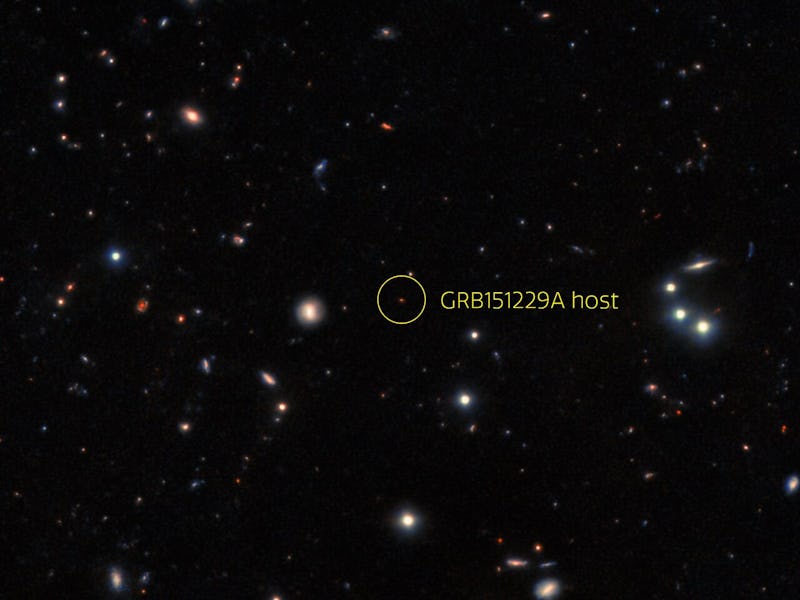Look! This distant galaxy hosted the most powerful explosion since the Big Bang
This thing was mind-boggling big.

The small, dim, red dot in the center of a newly-released image of a distant galaxy shows it endured one of the most powerful explosions since the Big Bang.
Astronomer Brendan O’Connor and his colleagues recently discovered this still-unnamed galaxy 9 billion light years away in data from the Gemini North Telescope in Hawai’i, and they say it’s the source of a brief, brilliant flare of gamma radiation that dazzled NASA’s Swift Observatory in late 2015.
Imagine an explosion releasing as much energy as our Sun will produce in 10 billion years – compressed into a burst of less than two seconds. Astronomers call this almost unimaginable cataclysm a short gamma-ray burst, and the universe hasn’t witnessed a brighter or more powerful explosion since the Big Bang. What could cause such an event? The answer seems to involve two neutron stars colliding.
Binary star systems aren’t vanishingly rare in the universe; one of our nearest neighbors, Alpha Centauri, is actually a pair of stars fairly similar to our Sun. On the other hand, binaries involving two neutron stars — the dense ball of neutrons left behind by the death of a star massive enough to cause a supernova, but not quite massive enough to collapse into a black hole — seem to be much rarer.
But every once in a while, a binary pair of neutron stars will pull each other into a gravitational death spiral, eventually colliding with enough force to release a brief burst of gamma rays brighter than a whole galaxy. Astrophysicists say this happens, in most galaxies, a few times every million years.
Most short gamma-ray bursts observed so far have happened in bright, nearby galaxies. But 43 of the ones detected by NASA’s Swift Observatory seemed to have come from the middle of nowhere — distant reaches of intergalactic space with no galaxy in sight. O’Connor and his colleagues recently traced most of those swift gamma bursts — including the 2015 explosion, dubbed GRB 151229A — to a previously-unnoticed group of very distant galaxies.
The circled galaxy in the center of this image is the source of a 2015 short gamma ray burst, according to O’Connor and his colleagues.
Short gamma-ray bursts are exactly what they sound like: short bursts of gamma rays. But they leave behind an afterglow of longer-wavelength radiation like X-rays. When Swift detects a gamma-ray burst, it uses the X-ray afterglow to pinpoint where in space the explosion came from. O’Connor and his colleagues searched through data from Gemini North, its sister observatory Gemini South in Chile, and the Keck Observatory in Hawai’i, looking for anything at the seemingly empty locations pinpointed by Swift.
They found galaxies — dim, distant, and old. Most of them, like the one in the image above, are between 8 and 10 billion light years from Earth. And that means the gamma-ray bursts coming from those galaxies happened 8 to 10 billion years ago, when the universe was much younger.
Until now, astronomers have thought that neutron stars collided even more rarely in the distant cosmic past than they seem to in the modern universe. But O’Connor and his colleagues say their newly-discovered ancient galaxies suggest that cataclysmic gamma-ray bursts were a regular occurrence even in the early universe. That could re-shape what we know about what the early universe was made of — and when those ingredients arrived.
Collisions between neutron stars are powerful enough to forge entirely new elements, including heavy metals like gold, platinum, and thorium. If neutron stars were colliding to produce short gamma-ray bursts 8 to 10 billion years ago, then they were also seeding the young universe with heavy elements much sooner than anyone thought.
“This pushes the timescale back on when the universe received the ‘Midas touch’ and became seeded with the heaviest elements in the periodic table,” O’Connor says in a statement.